#Bob Weiskopf
Explore tagged Tumblr posts
Text
Birthdays 11.9
Beer Birthdays
Peter Barbey (founder, Peter Barbey & Sons Brewery, Reading, Pennsylvania; 1825)
Jack Curtin
Five Favorite Birthdays
Gail Borden; dairyman, inventor (1801)
Hedy Lamarr; actor, inventor (1913)
Carl Sagan; scientist, writer (1934)
Anne Sexton; writer (1928)
Ed Wynn; actor (1886)
Famous Birthdays
Spiro T. Agnew; disgraced U.S. vice-president (1918)
Benjamin Banneker; mathematician, astronomer (1731)
Hermann Conring; German philosopher (1606)
Dorothy Dandridge; actor (1923)
Sandra "Pepa" Denton; pop singer (1964)
Edwin Drake; discovered oil in Pennsylvania (1819)
Marie Dressler; actor (1869)
David Duvel; golf player (1971)
Lou Ferrigno; actor, bodybuilder (1951)
Tom Fogerty; rock singer (1941)
Robert Frank; Swiss-American photographer (1924)
J. William Fulbright; politician, fellowship creator (1905)
Gigo Gabashvili; Georgian painter (1862)
Bob Gibson; St. Louis Cardinals P (1935)
Whitey Herzog; baseball player (1931)
Allama Muhammad Iqbal; Indian poet, philosopher (1877)
Velimir Khlebnikov; Russian poet and playwright (1885)
Nick Lachey; pop singer (1973)
Bohdan Lepky; Ukrainian author and poet (1872)
Elijah Lovejoy; abolitionist (1802)
Phil May; English singer-songwriter (1944)
Roger McGough; English author, poet, and playwright (1937)
Arthur Rudolph; German scientist and engineer (1906)
James Schuyler; poet and author 1923)
Giles Gilbert Scott, English architect, designed red telephone box (1880)
Sisqó; singer-songwriter and actor (1978)
Mikhail Tal; Latvian-Russian chess player (1936)
Heiti Talvik; Estonian poet (1904)
Susan Tedeschi; singer-songwriter (1970)
Lio Tipton; actor and model (1988)
Mary Travers; folk singer (1936)
Ivan Turgenev; Russian writer (1818)
Tom Weiskopf; golf player (1942)
Hermann Weyl; German mathematician, physicist, and philosopher (1885)
Stanford White; architect (1853)
1 note
·
View note
Photo

Bob Weiskopf was a staff writer on The Perry Como Show. He wrote a sketch for Fred Allen when the comic guested on the program. Weiskopf and Como were not getting along at the time. Allen read the sketch and found it funny and well-written.
Weiskopf recalled, “Fred and I walked in ... Como, the dumb ass, doesn’t know Fred has read the script. He reads it, the big executive at his desk, and literally throws the script across the room and says, ‘This is shit.’ I thought Fred was going to turn all colors of the rainbow ... [Como] was a terrible man.”
16 notes
·
View notes
Text
“The Lucy Show” ~ Season 3
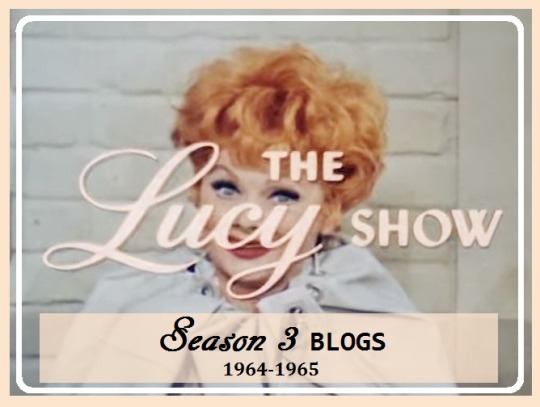
A handy dandy guide to helping you find your favorite episode blogs here at Papermoon Loves Lucy. Click on the hyperlinks to be taken directly to that episode’s trivia, background, and bloopers!

“Lucy and the Good Skate” (S3;E1) ~ September 21, 1964

“Lucy and the Plumber” (S3;E2) ~ September 28, 1964
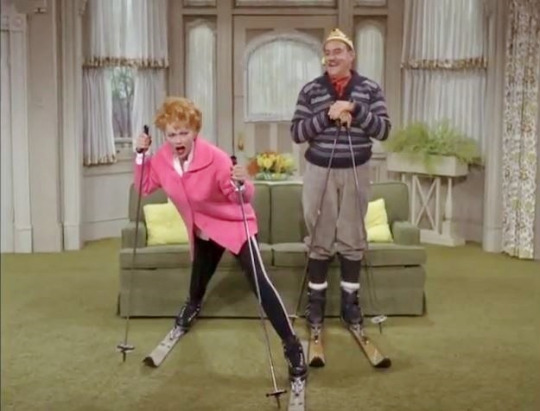
“Lucy and the Winter Sports” (S3;E3) ~ October 5, 1964

“Lucy Gets Amnesia” (S3;E4) ~ October 12, 1964

“Lucy and the Great Bank Robbery” (S3;E5) ~ October 19, 1964

“Lucy, the Camp Cook” (S3;E6) ~ October 25, 1964
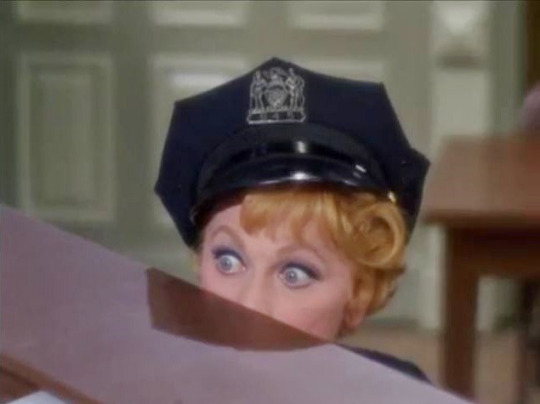
“Lucy, the Meter Maid” (S3;E7) ~ November 2, 1964

“Lucy Makes a Pinch” (S3;E8) ~ November 9, 1964
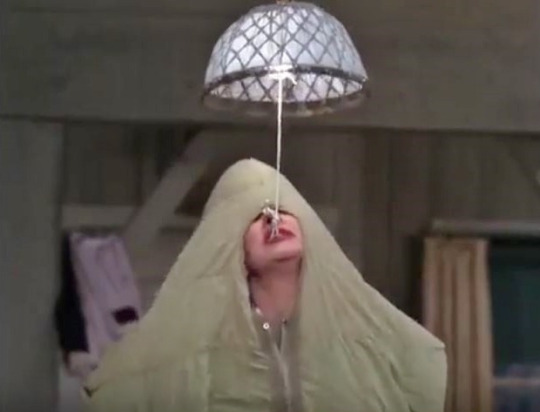
“Lucy Becomes a Father” (S3;E9) ~ November 16, 1964
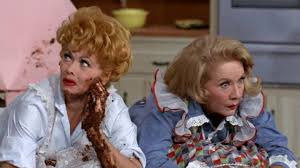
“Lucy’s Contact Lenses” (S3;E10) ~ November 23, 1964

“Lucy Gets Her Maid” (S3;E11) ~ November 30, 1964

“Lucy Gets the Bird” (S3;E12) ~ December 7, 1964

“Lucy, the Coin Collector” (S3;E13) ~ December 14, 1964
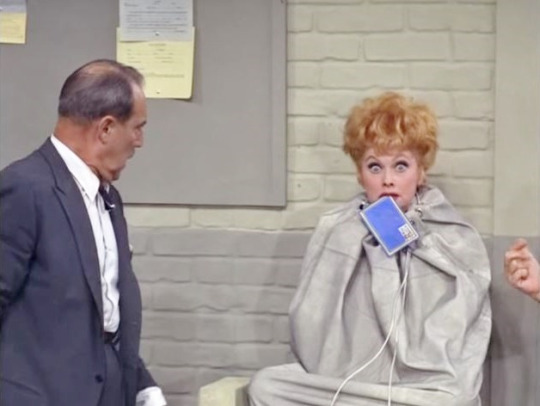
“Lucy and the Missing Stamp” (S3;E14) ~ December 21, 1964

“Lucy Meets Danny Kaye” (S3;E15) ~ December 28, 1964

“Lucy and the Ceramic Cat” (S3;E16) ~ January 11, 1965
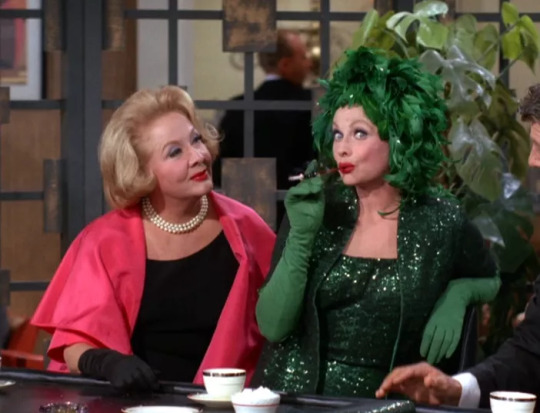
“Lucy Goes to Vegas” (S3;E17) ~ January 18, 1965
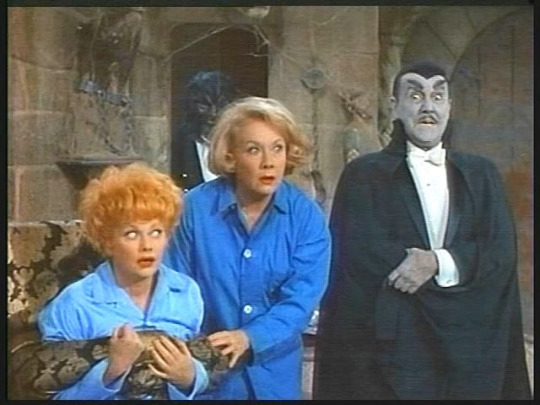
“Lucy and the Monsters” (S3;E18) ~ January 25, 1965

“Lucy and the Countess” (S3;E19) ~ February 1, 1965
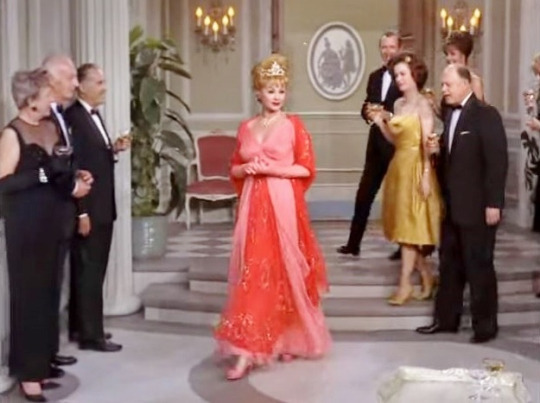
“My Fair Lucy” (S3;E20) ~ February 8, 1965

“Lucy and the Countess Lose Weight” (S3;E21) ~ February 15, 1965

“Lucy and the Old Mansion” (S3;E22) ~ March 1, 1965

“Lucy and Arthur Godfrey” (S3;E23) ~March 8, 1965
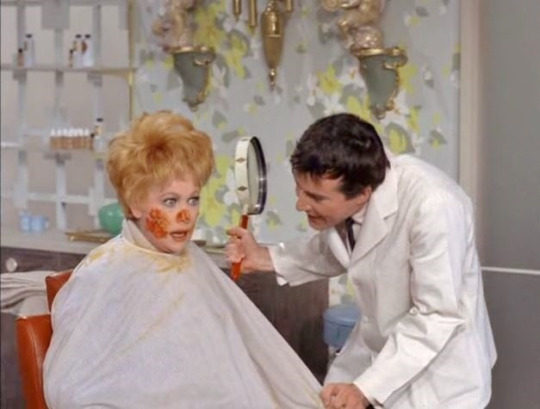
“Lucy and the Beauty Doctor” (S3;E24) ~ March 22, 1965
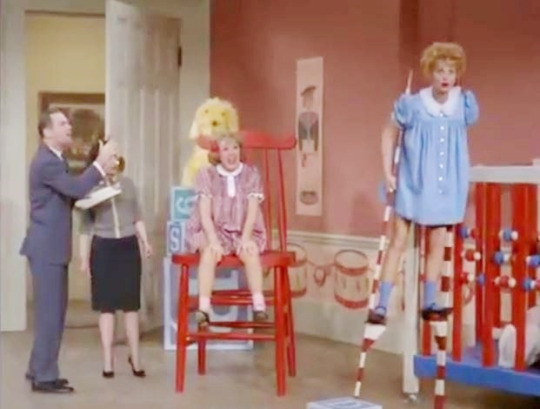
“Lucy the Stockholder” (S3;E25) ~ March 29, 1965

“Lucy the Disc Jockey” (S3;E26) ~ April 12, 1965
SEASON SUMMARY
Regular Cast: Lucille Ball (Lucy Carmichael), Vivian Vance (Vivian Bagley), Gale Gordon (Theodore J. Mooney), Jimmy Garrett (Jerry Carmichael), Ralph Hart (Sherman Bagley), Candy Moore (Chris Carmichael)
Recurring Characters: Keith Andes (Bill King), Ann Sothern (Rosie Harrigan, the Countess Frambois), Carole Cook (Mrs. Valance)
Guest Cast playing Characters: Jack Benny, Bob Hope, Fifi D’Orsay, Max Showalter, Sid Gould, Havey Korman, Madge Blake, Parley Baer, Joe Mell, Kathleen Freeman, Norma Varden, Mabel Albertson, Herb Vigran, Gary Morton, Louis A. Nicoletti, Reta Shaw, Norman Leavitt, Pat Harrington Jr.
Guest Cast playing Themselves: Danny Kaye, Arthur Godfrey, Dick Patterson
Live Animal Cast: Bear (Brownie), Cockatiel (Greenback), Cow (Bossie), Horse (Fury), Mouse (”Lucy and the Monsters”), Whippet (”My Fair Lucy”)
There were 26 new episodes
Episodes Written by Bob Weiskopf, Bob Schiller, Garry Marshall, Jerry Belson, Milt Josefsberg, Bob O’Brien, Ray Singer, Dick Chevillat, Leonard Gersche, Vic McLeod, Iz Ellinson, Fred S. Fox, Bob O’Hallaren, David Braverman, Bob Marcus
All episodes Directed by Jack Donohue
All episodes filmed in color, but originally aired by CBS in black and white
Filmed at Stage 21, Desilu Studios, Hollywood
Total Binge Hours: 13 hours (with commercials)
Papermoon’s Full Moon Pick: “My Fair Lucy” (E20)
Papermoon’s Half Moon Pick: “Lucy and the Ceramic Cat” (E16)
Season 2 was #8 in the ratings (down from #6) with a 26.6 share (down from 28.1). This was the lowest rated season of the series.
The opening credits changed again, introducing the kaleidoscope title sequence using clips of previous episodes.
Season 3 was released on DVD on November 30, 2010

#The Lucy Show#Lucille Ball#Vivian Vance#Gale Gordon#Ralph Hart#Candy Moore#Ann Sothern#CBS#TV#Jimmy Garrett#Jack Donohue#Bob Schiller#Bob Weiskopf#Leonard Gersche#Garry Marshall#1964#1965#DVD#Lucy Carmichael#bob hope#Jack Benny#Dick Patterson#Arthur Godfrey#Gary Morton
2 notes
·
View notes
Text
“I Love Lucy” ~ Season 6
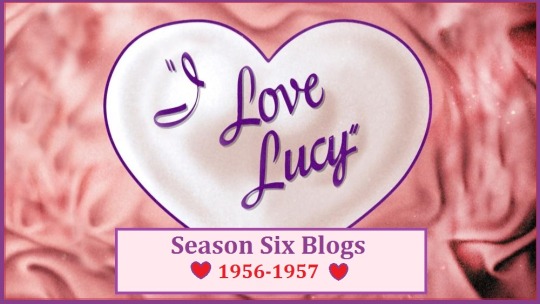
A handy dandy guide to helping you find your favorite episode blogs here at Papermoon Loves Lucy. Click on the hyperlinks to be taken directly to that episode’s trivia, background, and bloopers!
“Lucy and Bob Hope” (S6;E1) ~ October 1, 1956
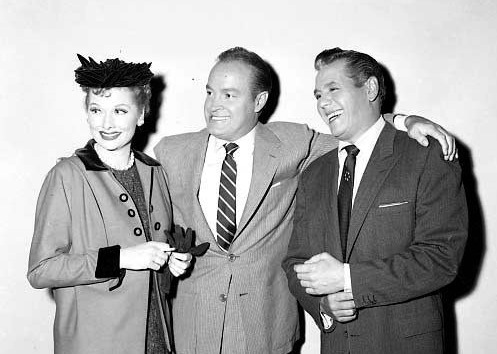
Directed by James V. Kern. Written by Madelyn Martin, Bob Carroll, Jr., Bob Schiller, and Bob Weiskopf. Filmed on June 5, 1956 at Ren-Mar Studios. Rating: 48.7/71
“Little Ricky Learns to Play the Drums” (S6;E2) ~ October 8, 1956

Directed by James V. Kern. Written by Madelyn Martin, Bob Carroll, Jr., Bob Schiller and Bob Weiskopf. Filmed June 28, 1956 at Ren-Mar Studios. Rating: 47.8/65
“Lucy Meets Orson Welles” (S6;E3) ~ October 15, 1956
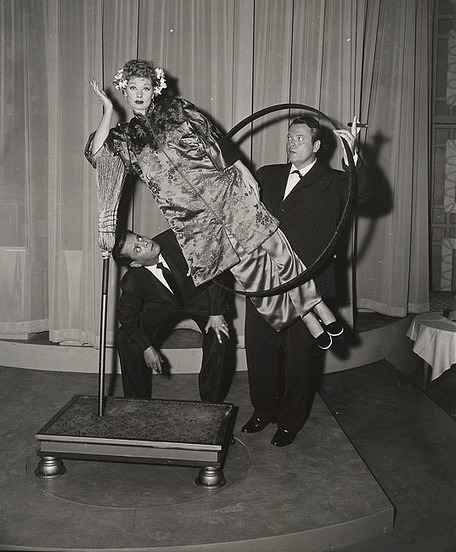
Directed by James V. Kern. Written by Madelyn Martin, Bob Carroll, Jr., Bob Schiller and Bob Weiskopf. Filmed June 14, 1956 at Ren-Mar Studios. Rating: 43.8/62
“Little Ricky Gets Stage Fright” (S6;E4) ~ October 22, 1956
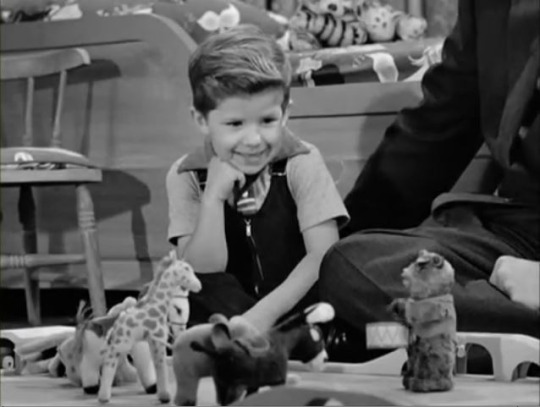
Directed by James V. Kern. Written by Madelyn Martin, Bob Carroll, Jr., Bob Schiller and Bob Weiskopf. Filmed June 21, 1956 at Ren-Mar Studios. Rating N/A
“Visitor From Italy” (S6;E5) ~ October 29, 1956
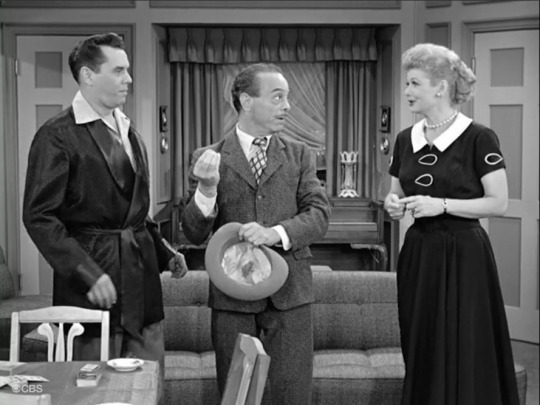
Directed by James V. Kern. Written by Madelyn Martin, Bob Carroll, Jr., Bob Schiller and Bob Weiskopf. Filmed September 24, 1956 at Ren-Mar Studios. Rating: 45.5/62
“Off to Florida” (S6;E6) ~ November 12, 1956
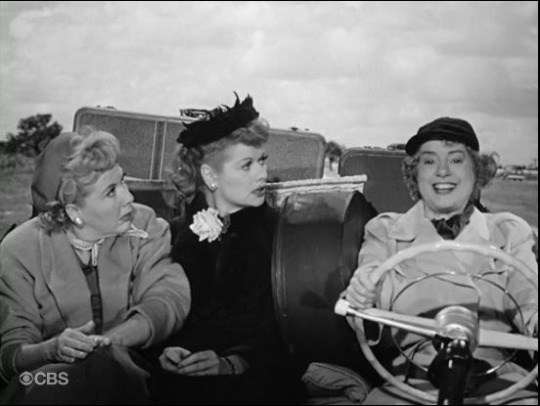
Directed by James V. Kern. Written by Madelyn Martin, Bob Carroll, Jr., Bob Schiller and Bob Weiskopf. Filmed September 13, 1956 at Ren-Mar Studios. Rating: 34.7/45
“Deep-Sea Fishing” (S6;E7) ~ November 19, 1956
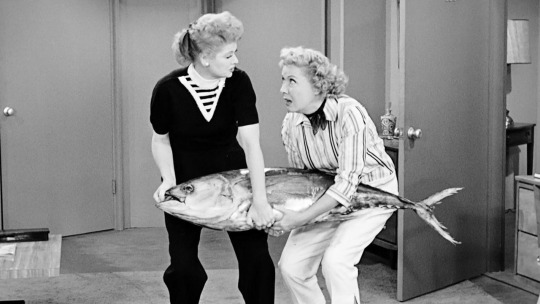
Directed by James V. Kern. Written by Madelyn Martin, Bob Carroll, Jr., Bob Schiller and Bob Weiskopf. Filmed September 27, 1956 at Ren-Mar Studios. Rating: 47.1/65
“Desert Island” (S6;E8) ~ November 26, 1956

Directed by James V. Kern. Written by Madelyn Martin, Bob Carroll, Jr., Bob Schiller and Bob Weiskopf. Filmed October 4, 1956 at Ren-Mar Studios. Rating: 46.7/63
“The Ricardos Visit Cuba” (S6;E9) ~ December 3, 1956

Directed by James V. Kern. Written by Madelyn Martin, Bob Carroll, Jr., Bob Schiller and Bob Weiskopf. Filmed October 18, 1956 at Ren-Mar Studios. Rating: 45.9/64
“Little Ricky’s School Pageant” (S6;E10) ~ December 17, 1956

Directed by James V. Kern. Written by Madelyn Martin, Bob Carroll, Jr., Bob Schiller and Bob Weiskopf. Filmed October 25, 1956 at Ren-Mar Studio. Rating: 43.4/63
“The ‘I Love Lucy’ Christmas Show” (S6;E11) ~ December 24, 1956

Directed by James V. Kern and William Asher. Written by Madelyn Martin, Bob Carroll, Jr., Bob Schiller and Bob Weiskopf. Filmed on November 22, 1956 at Ren-Mar Studios. Rating: N/A
“Lucy and the Loving Cup” (S6;E12) ~ January 7, 1957

Directed by James V. Kern. Written by Madelyn Martin, Bob Carroll, Jr., Bob Schiller, and Bob Weiskopf. Filmed on November 1, 1956 at Ren-Mar Studios. It was the 165th episode to be filmed. Rating: 50.9/68
“Lucy and Superman” (S6;E13) ~ January 14, 1957

Directed by James V. Kern. Written by Madelyn Martin, Bob Carroll, Jr., Bob Schiller and Bob Weiskopf. Filmed November 15, 1956 at Ren-Mar Studios. Rating: 48.1/65
“Little Ricky Gets a Dog” (S6;E14) ~ January 21, 1957
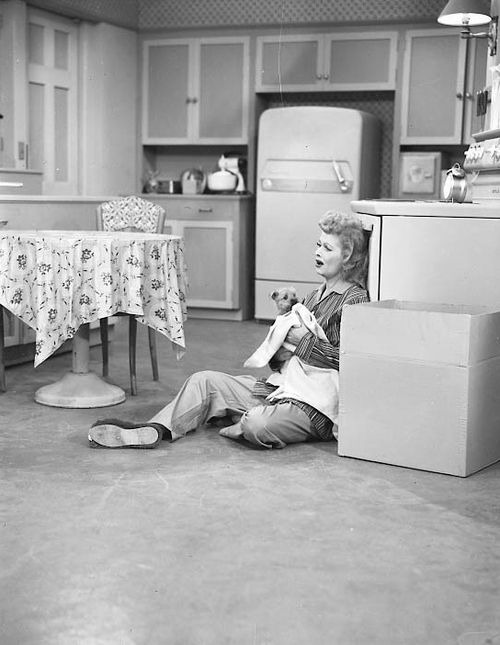
Directed by James V. Kern. Written by Madelyn Martin, Bob Carroll, Jr., Bob Schiller, and Bob Weiskopf. Filmed November 8, 1956 at Ren-Mar Studios. It was the 167th episode filmed. Rating: 45.1/61
“Lucy Wants to Move to the Country” (S6;E15) ~ January 28, 1957

Directed by William Asher. Written by Madelyn Martin, Bob Carroll, Jr., Bob Schiller and Bob Weiskopf. Filmed December 6, 1956 at Ren-Mar Studios. Rating: 42.1/56
“Lucy Hates to Leave” (S6;E16) ~ February 4, 1957
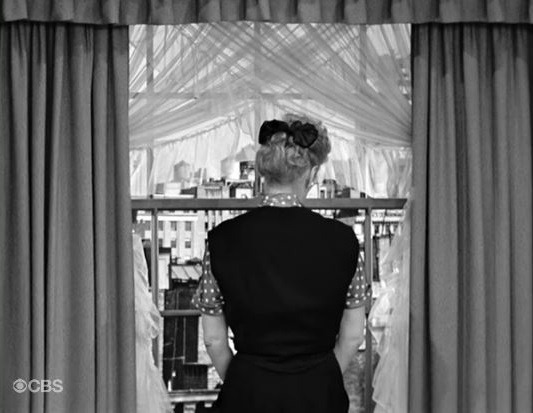
Directed by William Asher. Written by Madelyn Martin, Bob Carroll, Jr., Bob Schiller, and Bob Weiskopf. Filmed December 13, 1956 at Ren-Mar Studios. It was the 169th episode of 179. Rating: 42.5/57
“Lucy Misses the Mertzes” (S6;E17) ~ February 11, 1957

Directed by William Asher. Written by Madelyn Martin, Bob Carroll, Jr., Bob Schiller and Bob Weiskopf. Filmed on December 20, 1956 at Ren-Mar Studios. Rating: 38.8/50
“Lucy Gets Chummy with the Neighbors” (S6;E18) ~ February 18, 1957

Directed by William Asher. Written by Madelyn Martin, Bob Carroll, Jr., Bob Schiller, and Bob Weiskopf. Filmed on January 10, 1957 at Ren-Mar Studios. Rating: 38.0/49
“Lucy Raises Chickens” (S6;E19) ~ March 4, 1957
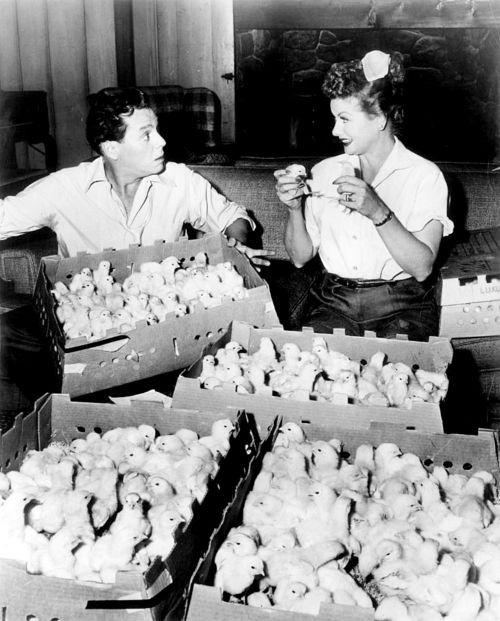
Directed by William Asher. Written by Madelyn Martin, Bob Carroll, Jr., Bob Schiller, and Bob Weiskopf. Filmed on January 17, 1957 at Ren-Mar Studios. Rating: 51.2/68
“Lucy Does the Tango” (S6;E20) ~ March 11, 1957

Directed by William Asher. Written by Madelyn Martin, Bob Carroll Jr., Bob Schiller, and Bob Weiskopf. Filmed February 5, 1957 at Ren-Mar Studios. Rating: 35.4/47
“Ragtime Band” (S6;E21) ~ March 18, 1957
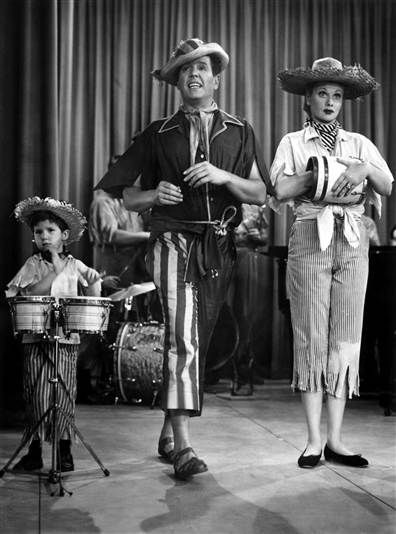
Directed by William Asher. Written by Madelyn Martin, Bob Carroll, Jr., Bob Schiller, and Bob Weiskopf. Filmed on February 14, 1957 at Ren-Mar Studios. Rating: 40.2/52
“Lucy’s Night in Town” (S6;E22) ~ March 25, 1957
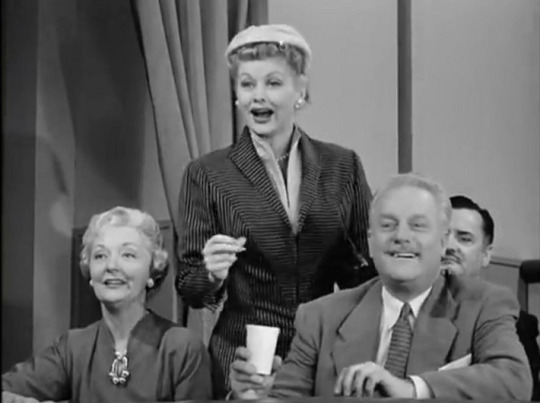
Directed by William Asher. Written by Madelyn Martin, Bob Carroll, Jr., Bob Schiller, and Bob Weiskopf. Filmed on February 21, 1957 at Ren-Mar Studios. Rating: 38.4/51
“Housewarming” (S6;E23) ~ April 1, 1957
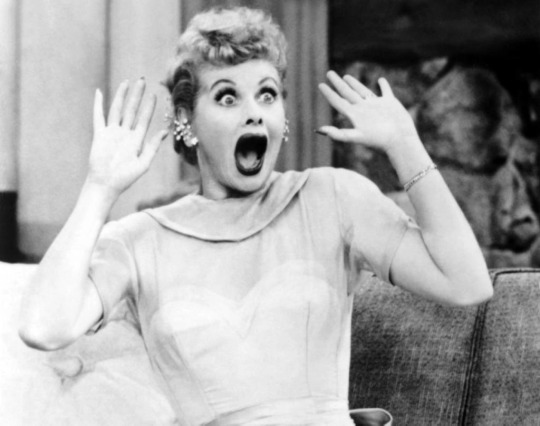
Directed by William Asher. Written by Madelyn Martin, Bob Carroll, Jr., Bob Schiller, and Bob Weiskopf. Filmed on February 28, 1957 at Ren-Mar Studios. Rating: 45.1/62
“Building a Bar-B-Q” (S6;E24) ~ April 8, 1957
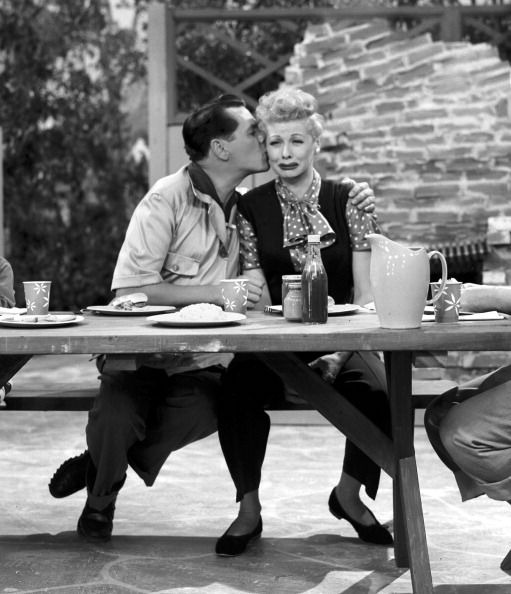
Directed by William Asher. Written by Madelyn Martin, Bob Carroll, Jr., Bob Schiller, and Bob Weiskopf. Filmed March 14, 1957 at Ren-Mar Studios. Rating: 42.1/56
“Country Club Dance” (S6;E25) ~ April 22, 1957
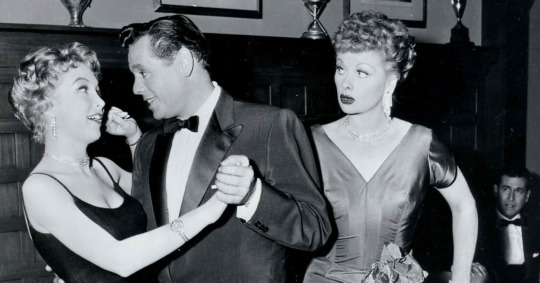
Directed by William Asher. Written by Madelyn Martin, Bob Carroll, Jr., Bob Schiller, and Bob Weiskopf. Filmed on March 21, 1957 at Ren-Mar Studios. Rating: N/A
“Lucy Raises Tulips” (S6;E26) ~ April 29, 1957
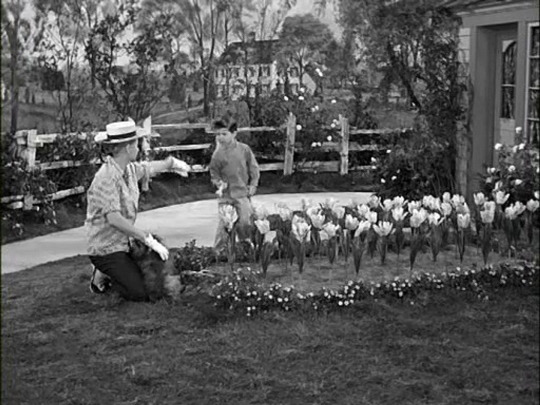
Directed by William Asher. Written by Madelyn Martin, Bob Carroll, Jr., Bob Schiller, and Bob Weiskopf. Filmed on March 28, 1957 at Ren-Mar Studios. Rating: 41.2/65
“The Ricardos Dedicate a Statue” (S6;E27) ~ May 6, 1957

Directed by William Asher. Written by Madelyn Martin, Bob Carroll, Jr., Bob Schiller and Bob Weiskopf. Filmed April 4, 1957 at Ren-Mar Studio. Rating: 35.6/56
SEASON SUMMARY
The season ended #1 in the ratings with an average 43.7 share.
The highest rated episode was “Lucy Raises Chickens” (E18) with a 51.2/68
The lowest rated episode was “Off To Florida” (E6) with a 34.7/45
There were 27 new episodes including “The ‘I Love Lucy’ Christmas Special.”
During the season, the setting of the series was shifted from New York City, to Westport, Connecticut. The series ‘traveled’ to Miami Beach and Havana, Cuba.
At the start of this season the name of Ricky’s nightclub has been changed from the Tropicana to Club Babalu.
Mrs. Trumbull (Elizabeth Patterson) made her last appearance in “Little Ricky Learns to Play the Drums” (E2).
Recurring Characters introduced: Fred the Dog (Danny), The Ramsey Family (Frank Nelson, Mary Jane Croft, and Ray Ferrell), Harry Munson (Tristram Coffin), Paul the Club Manager (Lou Krugman)
Guest Stars Playing Themselves: Bob Hope, Orson Welles, Claude Akins, Johnny & Hazel Longden, George Reeves (aka Superman), Jill Jarmyn, Joi Lansing
Guest Actors Playing Characters: Barbara Eden, Elsa Lanchester, Howard McNear, Ellen Corby, Madge Blake, Parley Baer, Strother Martin, Sandra Gould, Joseph Kearns, Desi Arnaz Jr.
The series introduced a new actor (the eighth) to play Ricky Ricardo Jr. - Keith Thibodeaux aka Richard Keith.
An average of 7,500 feet of film was shot per episode, for a total of 202,500 feet of film for season six.
“Lucy Does the Tango” (E2) holds the record for the longest laugh from the studio audience during any “I Love Lucy” episode: 65 seconds.
Papermoon’s Prime Pick: “Lucy’s Night In Town” (E22)
Papermoon’s Poor Pick: “Little Ricky Gets Stage Fright” (E4)
Total Binge Hours for Season Six: 13 ½ hours (with commercials); 10.8 hours (without commercials)
For the first time a full Christmas-themed episode was aired, expanding upon the Christmas tag developed in season 1. It was comprised of clips from several season 2 episodes and may be television’s first ‘clips show’. It did not enter syndication and was not seen by the public until 1999.
Colorized episodes: “The ‘I Love Lucy’ Christmas Special” (E11) and “Lucy and Superman (E13)
This season contains the final half-hour episode of “I Love Lucy,” although the characters will continue until April 1960 in hour-long specials now known as “The Lucy-Desi Comedy Hours”.
#I Love Lucy#Lucille Ball#Lucy#Desi Arnaz#Vivian Vance#William Frawley#1956#cbs#tv#1957#James V. Kern#Madelyn Martin#Bob Carroll Jr.#Bob Schiller#Bob Weiskopf#Ren-Mar Studios#Christmas#Cuba#Miami Beach#Elsa Lanchester#Keith Thibodeaux#Jay Novello#Bob Hope#Orson Welles#Season Six#Season 6#William Asher#Barbara Eden#Connecticut#Westport
5 notes
·
View notes
Text
Birthdays 11.9
Beer Birthdays
Peter Barbey (founder, Peter Barbey & Sons Brewery, Reading, Pennsylvania; 1825)
Jack Curtin
Five Favorite Birthdays
Gail Borden; dairyman, inventor (1801)
Hedy Lamarr; actor, inventor (1913)
Carl Sagan; scientist, writer (1934)
Anne Sexton; writer (1928)
Ed Wynn; actor (1886)
Famous Birthdays
Spiro T. Agnew; disgraced U.S. vice-president (1918)
Benjamin Banneker; mathematician, astronomer (1731)
Dorothy Dandridge; actor (1923)
Sandra "Pepa" Denton; pop singer (1964)
Edwin Drake; discovered oil in Pennsylvania (1819)
Marie Dressler; actor (1869)
David Duvel; golf player (1971)
Lou Ferrigno; actor, bodybuilder (1951)
Tom Fogerty; rock singer (1941)
J. William Fulbright; politician, fellowship creator (1905)
Bob Gibson; St. Louis Cardinals P (1935)
Allama Muhammad Iqbal; Indian poet, philosopher (1877)
Nick Lachey; pop singer (1973)
Elijah Lovejoy; abolitionist (1802)
Mary Travers; folk singer (1936)
Ivan Turgenev; Russian writer (1818)
Tom Weiskopf; golf player (1942)
Standford White; architect (1853)
0 notes
Text
Ranking Lucy
All of Lucille Ball’s series and specials starring her “Lucy” character (excluding guest spots) ranked from best to worst, because this is what I’ve been doing with my life.
I Love Lucy (1951-1957): This one should be pretty self-explanatory.
The Lucy Show (Seasons 1-2) (1962-1964): The first two seasons of her follow up series are actually really funny and the focus on the lives and friendships of middle aged women is rare even today.
The Lucy-Desi Comedy Hour (1957-1960): To say this attempt to reconfigure I Love Lucy into a series of hour long specials didn’t go well would be an understatement. Not only was the Ball/Arnaz marriage falling apart behind the scenes, but the writers clearly had no idea how to stretch their formula to a full hour with tons of filler material, and the Celebrity Guest Stars all feel shoehorned in.
The Lucy Show (Seasons 3-6) (1964-1968): At the end of season 2 Ball had a falling out with her longtime writers Bob Carroll, Jr., Madelyn Davis, Bob Schiller, and Bob Weiskopf which led to them all quitting. While there were plenty of gag writers eager to work for Lucy, none of them ever understood her as well. To make things worse, Vance quit after season 3 to spend time with her husband, the show was retooled and even won some Emmys but there’s no denying the laughs were much less frequent.
Lucy Calls the President (1977): Best remembered as the last time Ball reunited with Vivian Vance, this hour long special from Bob Carroll Jr. and Madelyn Davis isn’t great, but it’s a funny enough farce that brought together the remaining Desilu stock company for one last go around.
Lucy Moves to NBC (1980): A historical curiosity, this time the “Lucy” character is Ball herself (albeit, one who’s never produced before-unlike the real life former Desilu president). The special was made to promote a production deal Ball had signed with the network that ultimately didn’t go anywhere, but one of the pilots she produced, starring Donald “Singin’ in the Rain” O’Connor, makes up the special’s last half hour. The rest of the special is just Ball cracking jokes with 80s NBC stars like Johnny Carson and Gary Coleman while she tries to put together a pilot, with Gale Gordon pulled out of the moth balls to co-star again. It’s a testament to her continued star power that a production deal would be announced with such fanfare, and an ominous sign that it couldn’t produce an actual show.
Here’s Lucy (1968-1974): This is the Lucy equivalent of late period Simpsons episodes, everyone just looks tired, and nobody seems to care about quality as long as they fill 30 minutes. The one episode anyone remembers guest starred Elizabeth Taylor and Richard Burton, then the two biggest stars in the world at a time when big stars didn’t do television. And yeah, it is the best episode. It was also the last time in her lifetime Ball would be at the center of the American pop culture conversation.
Life with Lucy (1986): Her last series, cancelled after only 8 episodes. This isn’t the worst thing she’s ever done, but damn is it hard to see a reason why this needs to exist, with Ball trying to do the same schtick she did in the 50s even though her body isn’t up to it anymore, and the sitcom had evolved past it in a post Norman Lear/Mary Tyler Moore world. This could’ve been her Golden Girls (then in its second season) but instead she pulled Gale Gordon out of retirement to rehash the same routine they’d done for years, and that had long since gone stale. It’s sad really.
Lucy Gets Lucky (1975): This hour long advertisement for the MGM Grand Hotel in Vegas can be hard to watch, with Ball and guest star Dean Martin obviously reading from cue cards while trying desperately to get some laughs from a stale premise that’s stretched far too thin.
Lucy in London (1966): A 1 hour spinoff from The Lucy Show, Ball apparently hated this special so much she refused to make another, even though she’d already signed a contract for two TV specials. And you can see why, there’s not a laugh in the thing, the guest stars are surprisingly D-list for her, and we haven’t even gotten to the bizarre and awkward mod-inspired music video/fashion montage. Truly a painful watch!
2 notes
·
View notes
Photo
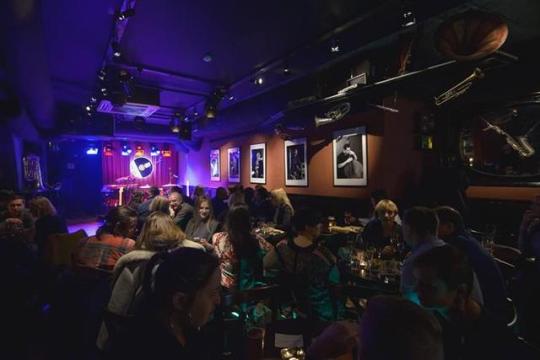
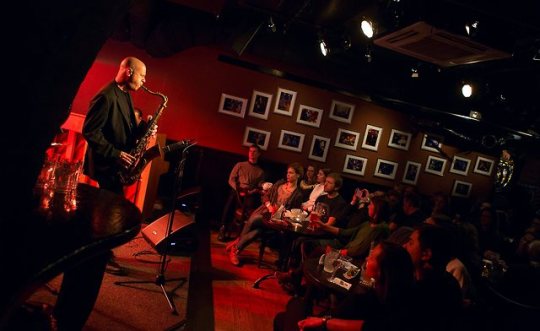
Jazz music - one of the biggest love in my life. I will never forget this night, not just because of music, but also this night is about the person I falled in love. There are few moments from Walt Weiskopf European Quartet concert.
For more than a decade Walt Weiskopf has been part of the legendary band Steely Dan. Weiskopf took over the seat after Chris Potter, and has thru that position made some name for himself. Weiskopf has realeased more than 10 albums in his own name, featuring jazz icons such as Brad Mehldau, Bill Stewart and John Patitucci. Weiskopf has chosen to work with a European trio that are considered state of the art. Winther, Lang, Mogensen are all three well estimed jazzmusicians, and known as the Best swingin' trio around Europe. They have individually toured and recorded with jazz greats such as Kevin Hays, Kurt Rosenwinkel, Jerry Bergonzi, Bob Berg, Brecker Brothers, Lew Soloff, Tim Hagans, David Liebman.
1 note
·
View note
Text
Bob Schiller, Writer on Beloved TV Comedies, Dies at 98
By NEIL GENZLINGER Mr. Schiller, often teamed with Bob Weiskopf, had to his credit numerous episodes of “I Love Lucy,” “Maude” and “All in the Family,” among others. Published: October 12, 2017 at 03:11PM via NYT http://ift.tt/2yhr3he
0 notes
Text
Bob Schiller, veteran 'I Love Lucy' <b>writer</b>, dies at 98
He began writing for television in 1950, and three years later formed a partnership with Bob Weiskopf, with whom he collaborated for nearly a ... http://ift.tt/2hAe8Pr
0 notes
Text
Golf's Greatest Drivers
One of golf's best-known aphorisms is 'Drive for show, putt for dough' but your chance to make a putt is somewhat reduced if you can't find the fairway, and then the green. At the very highest level the quality of ball-striking is such that tournaments are often won by the guy who has a hot putter that week, but week in and out driving is the bedrock on which a golfer's game is built. Sam Snead went as far as to say that you should only practice driving and putting.
And as with putting, many players can drive the ball well for a limited period but few can maintain consistent excellence over the course of a career that lasts decades. No-one can do it well all the time - even the absolute best have their off days and weeks - but these golfers did it better for longer than anyone else who lived.
20. Harold Hilton
The Englishman with the marvelous middle name of 'Horsfall' never turned pro but won two Opens at the end of the 19th century, four Amateur championships and a US Amateur, in the days when the very best were from the unpaid ranks. His most conspicuous quality was the straightness of his driving.
19. Tom Watson
Has a fast tempo but a great, simple, repetitive technique that gets the job done time and again. The greatest Major ever - 1977s duel in the sun with Nicklaus - was decided on the 72nd hole when he split the fairway to set up his winning birdie. Like many in this list the quality of his ball-striking never left him but the golfing gods decide that very few can have it all for too long, so his putting stroke headed south.
18. James Braid
One of the Great Triumvirate, along with Vardon and Taylor, Braid was the longest driver of the three and found more than his fair share of fairways. Won his five Open Championships in a 10-year stretch and even at age 78 shot a gross 74. Went on to become a notable architect whose courses, not surprisingly, put a premium on good tee shots.
17. Lee Trevino
Like so many other great drivers, his stock-in-trade was a controlled fade that worked with remarkable consistency. But his real genius was that when he needed to draw the ball he could. Very few have ever controlled ball-flight with the unfailing accuracy of SuperMex so it was no surprise that when he joined the US Seniors Tour (as it was then) it became his personal retirement fund.
16. Robert Tyre Jones
Possibly the best there has ever been but the shortness of his career makes a true comparison with modern greats impossible. Thirteen Majors in seven years tells its own story and they were built on a loose, rhythmical, flowing swing that usually sent the ball exactly where it was meant to go.
15. Nick Faldo
Golf's Greatest Living Englishman calculatedly sacrificed some of the length of his youth in order to develop the metronomic swing that gave him six Majors. The benefits were never more clearly demonstrated than at Muirfield in 1992 when, under pressure from John Cook he nailed it on the 72nd hole to set up his championship winning par.
14. Joyce Wethered
Arguably the greatest woman golfer ever to pull on spikes, she was so impressive that even Bob Jones said he had never been so intimidated by anyone's play. Henry Cotton added: 'I do not think a golf ball has ever been hit, except perhaps by Harry Vardon, with such a straight flight by any other person.' She won five English Amateur and four Amateur Championships and retired far too early.
13. Byron Nelson
Also retired when still in his prime - at age 34 (because of haemophilia and a dislike of the Tour pro's life) and, unlike most in this list, eschewed a controlled fade or draw in favour of simply hitting it straight. It was something he did so well that in 1945 he won 18 tournaments, 11 of them on the bounce, for the greatest streak of all time.
12. Ernie Els
The affable South African does everything well but it all starts on the teeing ground and in the modern era he has the winning combination of both length and accuracy. He's such a powerful hitter that he can nudge his Titleist out there over 300 yards without apparent effort, so he invariably retains control.
11. Jim Furyk
US Open winners cannot afford to be wild off the tee and, while not up there with the longest in the game, Furyk's unorthodox style gives him the repeatability for which most golf pros would sell their grandmothers. Now recovered from wrist surgery he perpetually demonstrates that anyone who can hit fairways and greens will be tough to beat.
10. Ben Hogan
Hogan, like many Texans who grow up trying to hit the ball low under the wind, developed a chronic hook that almost put paid to his career but by bloody-minded determination and unceasing practice he made himself into one of the best drivers ever. So much so that the sixth hole at Carnoustie has been re-named 'Hogan's Alley' in honour of the narrow strip of grass between bunkers and OB that he found all four days in 1953 en route to victory and his only claret jug in the only Open in which he competed.
9. Annika Sorenstam
Her iron play, particularly from 100 yards in, is exquisite, she has a fine putting touch and probably the best brain in women's golf but long, straight driving is the platform on which the best golfer in the world's game is based. So relentlessly does she thrash her opponents that an alternative career as a dominatrix beckons when she gives up golf.
8. Harry Vardon
Six Opens, which remains a record, and one US Open are the Majors tally for one of the purest ball-strikers ever to pick up a brassie or spoon. Challenged throughout his career by JH Taylor and James Braid he nevertheless was first among equals, mainly because of his great ability from the tee.
7. Tony Jacklin
Like Hogan, Vardon, Watson and others in this list he continued to be a superlative striker of the ball long after his scoring ability was sabotaged by a dodgy putting stroke. But we shall remember him always for the athleticism and power of his tee shots, summed up by Henry Longhurst with the words 'What a corker!' as Jacklin unleashed a superlative drive on the 18th at Royal Lytham and St Annes in 1969 for his only Open win on this side of the Atlantic.
6. Jack Nicklaus
The greatest ever had a swing characterised as 'rock and block' that consisted of an upright action that, coupled with his strength, gave him the most telling power fade ever seen. He had the capacity to bludgeon a course but preferred to use brains as well as brawn and quietly pick its pockets. Eighteen Majors and 19 runners-up spots suggest that his driving was, err, really quite good.
5. Calvin Peete
Born black and dirt poor, with 18 siblings, Peete didn't even play golf until he was 23 and it was an unlikely sport to choose because he broke his left elbow as a boy and it wasn't set properly, leaving him unable to straighten his arm. Unexpectedly, the injury meant he was phenomenally straight and he topped the US Tour driving accuracy stats for 10 straight years. And as Lee Trevino said: 'He straightens his arm to take the cheque.'
4. Colin Montgomerie
For seven unbelievable years Monty never had to have his golf shoes cleaned because he didn't know where the rough was and simply walked down the middle of the newly-mown grass. He famously never practised - because he never needed to. Stroll on the tee, hit driver to right centre, find the green and hole the putt. Piece of piss to a trained athlete.
3. Sir Henry Cotton
It was said of the three-time Open winner (by US coach Bob Toski) that he was so unyieldingly straight from the tee that it was impossible to determine if his ball was in the left or right side of the fairway. Cotton knew how good he was and didn't shy away from telling others but most of them could see it for themselves whenever he drove the ball.
2. Sam Snead
Quite possibly the most naturally gifted player ever, Snead's swing was so fluid that it was likened to pouring molasses over treacle and the epithet 'Slammin' Sam' always did him a great disservice because he was a pure swinger, not a hitter. He won 84 US Tour events - a record still to be beaten, over six different decades, five Majors and recorded 34 holes-in-one. He remained good enough to finish third in the US PGA at age 62 and throughout it all his driving was the lynchpin.
1. Greg Norman
His career spanned the change from persimmon to titanium but he was equally good with either. Previously, golfers tended to be either long or straight but none before or since has combined the two to such telling effect. Like a Federer serve or Lillee bouncer, Norman's tee shot was the ace in his hand that he knew he could rely on when it really counted. Two Opens are scant reward for one so talented but his final 18 holes at Royal St George's in 1993 when he lifted the claret jug for the second time is possibly the greatest driving round ever seen. When the pressure was really on he showed frailty with his iron approach shots but with a wood in his hands he was peerless.
Huge but haywire Tiger Woods: Only a man with his genius could contend as often he does without ever finding a fairway. John Daly: The enormous backswing means that if his timing is just a fraction out - which it often is - then the ball could go anywhere. Laura Davies: Wallops it like an angry man, and just as unpredictable. Hank Kuehne: Tall, pencil-thin American who, like Gerald Ford, doesn't know which course he's playing until after the first tee shot comes to rest.
Back to the practice ground Thomas Bjorn: In this year's European Open put three balls into the River Liffey on the 71st hole before eventually signing off with an 11, on his way to shooting 86. Seve Ballesteros: Once suggested that all courses should have no fairways, so that everyone else would have to play from the rough, too. Jose Maria Olazabal: Often couldn't find a fairway with GPS but such are his powers of recovery, and iron play, that it didn't matter. Ben Crenshaw: Tom Weiskopf said of him: 'He hits in the woods so often he should get an orange hunting jacket.' Arnold Palmer: Only knew one way to play and that was to thrash it as hard as possible [https://golfuniversityau.com/], with rather inevitable consequences.
0 notes
Text
Birthdays 11.9
Beer Birthdays
Peter Barbey (founder, Peter Barbey & Sons Brewery, Reading, Pennsylvania; 1825)
Jack Curtin
Five Favorite Birthdays
Gail Borden; dairyman, inventor (1801)
Hedy Lamarr; actor, inventor (1913)
Carl Sagan; scientist, writer (1934)
Anne Sexton; writer (1928)
Ed Wynn; actor (1886)
Famous Birthdays
Spiro T. Agnew; disgraced U.S. vice-president (1918)
Benjamin Banneker; mathematician, astronomer (1731)
Hermann Conring; German philosopher (1606)
Dorothy Dandridge; actor (1923)
Sandra "Pepa" Denton; pop singer (1964)
Edwin Drake; discovered oil in Pennsylvania (1819)
Marie Dressler; actor (1869)
David Duvel; golf player (1971)
Lou Ferrigno; actor, bodybuilder (1951)
Tom Fogerty; rock singer (1941)
Robert Frank; Swiss-American photographer (1924)
J. William Fulbright; politician, fellowship creator (1905)
Gigo Gabashvili; Georgian painter (1862)
Bob Gibson; St. Louis Cardinals P (1935)
Whitey Herzog; baseball player (1931)
Allama Muhammad Iqbal; Indian poet, philosopher (1877)
Velimir Khlebnikov; Russian poet and playwright (1885)
Nick Lachey; pop singer (1973)
Bohdan Lepky; Ukrainian author and poet (1872)
Elijah Lovejoy; abolitionist (1802)
Phil May; English singer-songwriter (1944)
Roger McGough; English author, poet, and playwright (1937)
Arthur Rudolph; German scientist and engineer (1906)
James Schuyler; poet and author 1923)
Giles Gilbert Scott, English architect, designed red telephone box (1880)
Sisqó; singer-songwriter and actor (1978)
Mikhail Tal; Latvian-Russian chess player (1936)
Heiti Talvik; Estonian poet (1904)
Susan Tedeschi; singer-songwriter (1970)
Lio Tipton; actor and model (1988)
Mary Travers; folk singer (1936)
Ivan Turgenev; Russian writer (1818)
Tom Weiskopf; golf player (1942)
Hermann Weyl; German mathematician, physicist, and philosopher (1885)
Stanford White; architect (1853)
0 notes
Text
British Open
British Open, officially the Open Championship or the Open, one of the world’s four major golf tournaments—with the Masters Tournament, the U.S. Open, and the Professional Golfers’ Association (PGA) Championship—and the oldest continually run championship in the sport. Best known outside the United States as the Open Championship or, simply, the Open, it has been held annually (with a few exceptions) on various courses in Scotland, England, and—on one occasion—Northern Ireland since 1860. History The first Open Championship was played on October 17, 1860, at Prestwick Golf Club in Scotland. A field of eight professionals played three rounds of Prestwick’s 12-hole course in one day. Willie Park, Sr., won the inaugural tournament and was presented with the Challenge Belt, a silver-buckled leather belt that each champion was to keep until the following Open. The tournament was opened to amateurs in 1861. In 1863 a purse of £10—which was to be shared among the professionals who finished in second, third, and fourth place—was introduced, and a first-place cash prize of £6 was added in 1864. In 1870 Tom Morris, Jr., won the Open for the third consecutive time and was thus allowed to keep the Challenge Belt permanently. As there was no award to present to the winner, the Open was not held again until 1872, when it was determined that the winning golfer would receive the Golf Champion Trophy, now commonly known as the Claret Jug. In 1892 the Open became a 72-hole event (four rounds of 18 holes), and in 1898 a cut (reduction of the field) was introduced after the first two rounds of play. The Open has always been dominated by professionals, with only six victories by amateurs, all before 1930. The last of those was Bobby Jones’s third Open, which was part of his celebrated Grand Slam (four major tournament victories in one calendar year). The popularization of golf in the mid-20th century produced a string of noteworthy Open champions, including England’s Sir Henry Cotton (winner in 1934, 1937, and 1948), South Africa’s Bobby Locke (1949–50, 1952, 1957), Australia’s Peter W. Thomson (1954–56, 1958, 1965), and the United States’ Arnold Palmer (1961–62) and Tom Watson (1975, 1977, 1980, 1982–83). Watson’s final win in 1983 ended an era of U.S. domination, during which American golfers won 12 times in 14 years. For the next 11 years there was only one American winner, with the Claret Jug going to Spain’s Seve Ballesteros, Australia’s Greg Norman, and England’s Nick Faldo, among others. In 1995 the Open became part of the PGA Tour’s official schedule. American John Daly won that year after a play-off with Italy’s Costantino Rocca, beginning another period of American supremacy at the Open in which 10 of the next 13 winners hailed from the United States, including Tiger Woods, who won three championships (2000, 2005–06). Subsequent years saw a number of victories by golfers for whom the Open was their first major tournament triumph, including Paul Lawrie in 1999, David Duval in 2001, Ben Curtis in 2003, and Padraig Harrington in 2007. Another notable Open champion is Jack Nicklaus, who won in 1966, 1970, and 1978 and placed in the top five 16 times, including seven second-place finishes. Harry Vardon won the Open six times—more than any other player—and four golfers, including Thomson and Watson, won five championships. South African Gary Player, who won the title in 1968 and 1974, holds the record for the most appearances in the Open, with 46. Courses The Open Championship has always been played on links courses (mostly treeless golf courses that are built along a coast and retain the natural uneven terrain of their locations). From 1860 to 1870 the Open was played exclusively at Prestwick Golf Club. Since 1872 it has been played at a number of courses in rotation. Initially the three courses were Prestwick, St. Andrews, and Musselburgh, all located in Scotland. The nine courses in the current rotation are the Old Course at St. Andrews; Carnoustie Golf Links in Carnoustie, Scotland; Muirfield in Gullane, Scotland; the Ailsa Course at the Westin Turnberry Resort, outside Girvan, Scotland; Royal Troon Golf Club in Troon, Scotland; Royal St. George’s Golf Club in Sandwich, England; Royal Birkdale Golf Club in Southport, England; Royal Lytham & St. Annes Golf Club in Lytham St. Annes, England; and Royal Liverpool Golf Club in Hoylake, England. The Open is a unique event and is of great importance to professionals and amateur golfers alike, as well as to fans of golf. Unlike the play of other majors—which are typically contested in sunny locales in the United States—the outcome of the Open is often influenced by the weather. On a links course, morning and afternoon tee times can produce vastly different playing conditions, depending on the breeze that comes in off the sea. The weather is just one of the many unique features of the Open that combine with its long history and prestigious reputation to make it an event unparalleled in golf. This author, who experienced a warm reception from his home crowd when he finished second to Tiger Woods at St. Andrews in 2005, looks forward to competing in the Open every year. To him, the Open is pure romance and theatre, and it truly is a special event that every golfer dreams of winning. British Open Winners year winner* 1860 Willie Park, Sr. 1861 Tom Morris, Sr. 1862 Tom Morris, Sr. 1863 Willie Park, Sr. 1864 Tom Morris, Sr. 1865 Andrew Strath 1866 Willie Park, Sr. 1867 Tom Morris, Sr. 1868 Tom Morris, Jr. 1869 Tom Morris, Jr. 1870 Tom Morris, Jr. 1871 not held 1872 Tom Morris, Jr. 1873 Tom Kidd 1874 Mungo Park 1875 Willie Park, Sr. 1876 Bob Martin 1877 Jamie Anderson 1878 Jamie Anderson 1879 Jamie Anderson 1880 Bob Ferguson 1881 Bob Ferguson 1882 Bob Ferguson 1883 Willie Fernie 1884 Jack Simpson 1885 Bob Martin 1886 David Brown 1887 Willie Park, Jr. 1888 Jack Burns 1889 Wille Park, Jr. 1890 John Ball 1891 Hugh Kirkaldy 1892 Harold Hilton 1893 William Auchterlonie 1894 J.H. Taylor 1895 J.H. Taylor 1896 Harry Vardon 1897 Harold Hilton 1898 Harry Vardon 1899 Harry Vardon 1900 J.H. Taylor 1901 James Braid 1902 Sandy Herd 1903 Harry Vardon 1904 Jack White 1905 James Braid 1906 James Braid 1907 Arnaud Massy (France) 1908 James Braid 1909 J.H. Taylor 1910 James Braid 1911 Harry Vardon 1912 Ted Ray 1913 J.H. Taylor 1914 Harry Vardon 1915–19 not held 1920 George Duncan 1921 Jock Hutchison (U.S.) 1922 Walter Hagen (U.S.) 1923 Arthur Havers 1924 Walter Hagen (U.S.) 1925 Jim Barnes (U.S.) 1926 Bobby Jones (U.S.) 1927 Bobby Jones (U.S.) 1928 Walter Hagen (U.S.) 1929 Walter Hagen (U.S.) 1930 Bobby Jones (U.S.) 1931 Tommy Armour (U.S.) 1932 Gene Sarazen (U.S.) 1933 Denny Shute (U.S.) 1934 Henry Cotton 1935 Alf Perry 1936 Alf Padgham 1937 Henry Cotton 1938 Reg Whitcombe 1939 Dick Burton 1940–45 not held 1946 Sam Snead (U.S.) 1947 Fred Daly (Ire.) 1948 Henry Cotton 1949 Bobby Locke (S.Af.) 1950 Bobby Locke (S.Af.) 1951 Max Faulkner 1952 Bobby Locke (S.Af.) 1953 Ben Hogan (U.S.) 1954 Peter Thomson (Austl.) 1955 Peter Thomson (Austl.) 1956 Peter Thomson (Austl.) 1957 Bobby Locke (S.Af.) 1958 Peter Thomson (Austl.) 1959 Gary Player (S.Af.) 1960 Kel Nagle (Austl.) 1961 Arnold Palmer (U.S.) 1962 Arnold Palmer (U.S.) 1963 Bob Charles (N.Z.) 1964 Tony Lema (U.S.) 1965 Peter Thomson (Austl.) 1966 Jack Nicklaus (U.S.) 1967 Roberto de Vicenzo (Arg.) 1968 Gary Player (S.Af.) 1969 Tony Jacklin 1970 Jack Nicklaus (U.S.) 1971 Lee Trevino (U.S.) 1972 Lee Trevino (U.S.) 1973 Tom Weiskopf (U.S.) 1974 Gary Player (S.Af.) 1975 Tom Watson (U.S.) 1976 Johnny Miller (U.S.) 1977 Tom Watson (U.S.) 1978 Jack Nicklaus (U.S.) 1979 Seve Ballesteros (Spain) 1980 Tom Watson (U.S.) 1981 Bill Rogers (U.S.) 1982 Tom Watson (U.S.) 1983 Tom Watson (U.S.) 1984 Seve Ballesteros (Spain) 1985 Sandy Lyle 1986 Greg Norman (Austl.) 1987 Nick Faldo 1988 Seve Ballesteros (Spain) 1989 Mark Calcavecchia (U.S.) 1990 Nick Faldo 1991 Ian Baker-Finch (Austl.) 1992 Nick Faldo 1993 Greg Norman (Austl.) 1994 Nick Price (Zimb.) 1995 John Daly (U.S.) 1996 Tom Lehman (U.S.) 1997 Justin Leonard (U.S.) 1998 Mark O'Meara (U.S.) 1999 Paul Lawrie 2000 Tiger Woods (U.S.) 2001 David Duval (U.S.) 2002 Ernie Els (S.Af.) 2003 Ben Curtis (U.S.) 2004 Todd Hamilton (U.S.) 2005 Tiger Woods (U.S.) 2006 Tiger Woods (U.S.) 2007 Padraig Harrington (Ire.) 2008 Padraig Harrington (Ire.) 2009 Stewart Cink (U.S.) 2010 Louis Oosthuizen (S.Af.) 2011 Darren Clarke 2012 Ernie Els (S.Af.) 2013 Phil Mickelson (U.S.) 2014 Rory McIlroy 2015 Zach Johnson (U.S.) 2016 Henrik Stenson (Swed.) 2017 Jordan Spieth (U.S.) 2018 Francesco Molinari (Italy)
0 notes
Text
BOB WEISKOPF
March 13, 1914

Bob Weiskopf was born in Chicago, Illinois. He became an Emmy-winning writer and producer for television. At the start of World War II, he moved in with writer Jess Oppenheimer, who 13 years later would hire him to write for “I Love Lucy". Weiskopf was hired to write radio comedy for the legendary comedian Fred Allen. He served in the US military.

He began writing for television in 1950, when he wrote an episode for “The Colgate Comedy Hour” featuring Fred Allen. His creative partnership and friendship with Bob Schiller began in 1953 writing a single radio script for “Our Miss Brooks” before delving into the new media of television together. They wrote for such popular shows as “Make Room for Daddy” (filmed at Desilu), “The Bob Cummings Show,” “I Love Lucy,” “The Lucy-Desi Comedy Hour,” Desilu’s “The Ann Sothern Show” (which they co-created), and “Pete and Gladys”.

Weiskopf joined the “I Love Lucy” writing staff for season five, starting with “Lucy Visits Graumans” (ILL S5;E1) in Fall 1955. This was his first time writing for Lucille Ball.

He continued writing for the show until it’s final episode (53 in all) and continued writing all 13 episodes of “The Lucy Desi Comedy Hour” through the end of 1959.

In between he wrote the pilot script for “The Ann Sothern Show”, an outgrowth of “Private Secretary” created by Desilu when Sothern came to a creative impasse with the previous producers. Lucille Ball played Lucy Ricardo on the series at the start of season two.

He acted as script consultant in 1959 when Lucy and Desi appeared on “Sunday Showcase: The Lucy-Desi Milton Berle Special” assuring that the Ricardo characters were consistently written for Berle’s special. He served in the same capacity for “The Desilu Revue” a holiday variety show for the “Westinghouse Desilu Playhouse” in December 1959.

In the 1960s and 1970s they continued their partnership with such series as “The Lucy Show,” “The Red Skelton Show,” “The Good Guys” (where they were also co-producers), “The Phyllis Diller Show,” “The Carol Burnett Show,” “The Flip Wilson Show,” “Maude” (which they also co-produced), “All in the Family,” and its spinoff series, ”Archie Bunker's Place.”

In 1960 he was one of the writers creating “Guestward Ho” for Desilu. The series was supposed to star Vivian Vance, but the network decided she was too associated with Ethel Mertz and the show was recast for the series. In 1961, Weiskopf was one of the writers of “Pete and Gladys”, a spin-off of Desilu’s “December Bride” that was not produced by Desilu.

In 1962, he returned to working for Desilu and Lucille Ball (as well as briefly for Desi Arnaz) on “The Lucy Show”.

Weiskopf was uncredited co-creator and wrote 48 episodes from season one through the end of 1964.
Although he wrote ten episodes of “The Carol Burnett Show” during season three, he was not a writer for Lucille Ball’s appearance in November 1969.

Weiskopf was, however, one of the writers of the second season opener of “Flip” that featured Lucille Ball. This would be Weiskopf’s last time writing for Ball.
During their long collaboration, Schiller and Weiskopf were honored with two Emmy Awards, a pair of Peabody Awards, a Golden Globe, and the Writers’ Guild of America's Paddy Chayefsky Laurel Award for Television Achievement.

His final writing credit was a 1986 episode of “He’s The Mayor.” He died in 2001 at age 86.
#Bob Weiskopf#Lucille Ball#I Love Lucy#The Lucy Show#Desi Arnaz#Bob Schiller#TV#Flip Wilson#Guestward Ho
0 notes
Text
Famous Designers : Vegas Actively playing golf Tutorials
Against your upcoming Vegas holiday getaway, invest in a creator occurrence. Virtually no, not much of a designer. Have fun with your game with actively playing golf during among the list of Vegas actively playing golf tutorials created by prominent actively playing golf designers. Who seem to could people often be? You should critique who seem to fashioned most of a prominent Vegas actively playing golf tutorials.
To start, a Paiute Destination around Vegas offers the exceptional natural beauty on the Southern area The state of nevada desert the game of golf along at the foothills of your Originate Heaps. Created by world-renowned Peter Dye, a some actively playing golf tutorials around this destination give tricky loopholes plus rough outdoors panorama. Such as, a Environments Mountain / hill lessons is definitely runs by using railway ties plus waters threats this harmonize with a inviting fairways among the list of all-natural desert geography. Actively playing golf Understand given its name Environments Mountain / hill as being the "Number A person Consumer Obtain Lessons around The state of nevada. inches The sunlight Mountain / hill Lessons as well as Bad guy Lessons during Paiute Actively playing golf Destination give very similar, astounding models.
A further Peter Dye lessons is a Desert Pines The game of golf. If perhaps you are looking at a wooded beauty on the Pinehurst the game of golf involved with your desert place, have fun with your game during Desert Pines The game of golf. A lessons is definitely an example of three Vegas actively playing golf tutorials worked by way of Walters Actively playing golf. Other some involve Bali Hai The game of golf, Noble One-way links Golf wedge plus Stallion Mountain / hill Place Pub. Them benefits countless adult this tree flowers flanking a fairways. White colored crushed lime stone bunkers secure massive, undulating vegetation. Quick grown timbers . dry ecosystem while in the Vegas desert weather conditions, in search of outside 19 loopholes currently have waters around have fun with. Palm Beach architects
The writer Moorish fashioned a Displayed Desert Golf wedge. The following A actively playing golf builder caused Robert Trent Jones, George Fazio plus Jack port Nicklaus. Your dog fashioned Monster Shape Golf wedge by using Bob Druzinsky. Mr. Morrish teamed right up by using Dan Weiskopf to make plus make a variety of actively playing golf tutorials, a number which have been provided among the list of Top rated 100 Ough. Vertisements. actively playing golf tutorials.
A Country's Golf wedge with Vegas appeared to be created by Bert Stamps. A lessons showed around 1961 plus has become the most seasoned Vegas actively playing golf tutorials. Mr. Stamps includes fashioned all kinds of other actively playing golf tutorials in the Ough. Vertisements. for example the Mesquite Actively playing golf & Place Pub around Claws Springs as well as De Leveaga The game of golf around Santa claus Johnson, Ohio. Padraig harrington acquired her initially PGA succeed along at the 1996 Vegas Foreign. Mickey Wright acquired not one but two LPGA competition around this lessons. Scrub muscles by using track record plus have fun with your game along at the Vegas Country's Golf wedge.
A Silverstone The game of golf around among the list of remarkable Vegas actively playing golf tutorials. This training manual contains a Vegas Super star Game enthusiasts Head to and offers your top-rated actively playing golf practical experience for some tutorials for anyone game enthusiasts, all of years plus all of ability. Silverstone Golf wedge appeared to be created by Robert Cupp, having made consumer plus confidential tutorials out of Boca Raton, The southwest so that you can Palmetto Sugar plantation Arena around Hilton Travel. Mr. Cupp fashioned alternative area Vegas actively playing golf tutorials for instance Wildhorse The game of golf around Henderson, The state of nevada as well as Angel 9 lessons during Angel Store The game of golf around Vegas.
A Badlands Golf wedge appeared to be created by qualified golf players Ashton Burns plus Chi Chi Rodriguez. A actively playing golf course's term echoes the experience: wonderful panorama contrasted by using damaging, limit fairways this crossstitching quite a few pretty prickly desert landscape designs.
Continue, yet not smallest, will be actively playing golf tutorials created by Arnold Palmer plus Jack port Nicklaus. Arnie fashioned not one but two attractive 18-hole tutorials during Angel Store, as well as Arroyo Lessons during Purple Mountain Place Pub.
Jack port Nicklaus fashioned a Bear's Most effective Golf wedge, which will benefits 19 actively playing golf loopholes; each one golf hole is definitely patterned following on from the most effective loopholes your dog made during alternative tutorials your dog fashioned. A Senior Bear's bank lessons is definitely scenic plus tricky so that you can have fun with. A lessons started off business around 2001.
Make sure you have fun with your game during every and also every one of these tutorials during your upcoming Vegas actively playing golf holiday getaway. Just simply revealing your friends that you have gamed your creator lessons will be worth a vegetation rates.
0 notes
Text
USA: Latest News from Walt Weiskopf - Vol. 12, September 2018
Check Out My New Website! Over the summer, I have been working with a team to renovate my old website. I am now very excited to announce to you the unveiling of the newly redesigned www.WaltWeiskopf.com where you'll find my CDs, books, videos, and more than 150 downloadable charts for quartet, quintet, sextet, octet, nonet, large ensemble and big band available for purchase. Be sure to check it out and let me know what you think! New Album Getting Great Reviews My new CD “Walt Weiskopf European Quartet, featuring the great musical talents of pianist Carl Winther, bassist Daniel Franck, and drummer Anders Mogensen, is getting terrific reviews like this one: "This is some of the best jazz we have heard this year. Playing with three of Europe’s finest musicians – pianist Carl Winther, bassist Daniel Franck and drummer Anders Mogensen – this recording captures all the beauty and joy of the music of Weiskopf....If you love jazz, this is a must-have. Get it today!" - Bob Leggett, Indie Voice Blog. Check out the entire review and follow his blog HERE.
Follow Me
Stay in touch with me on Instagram, Twitter and Facebook!
Official Website: WaltWeiskopf.com
via Blogger https://ift.tt/2MOM2m2
0 notes
Text
Live Update: Masters, Trivia Quiz | FOX Sports
New Post has been published on https://livevsongame-tv.com/golf/live-update-masters-trivia-quiz-fox-sports/20661/html
Live Update: Masters, Trivia Quiz | FOX Sports


AUGUSTA, Ga. (AP) How well do your know the Masters? Try this quiz:
1. Which former British Open champion never broke par at the Masters?
a.) John Daly
Article continues below …
b.) Bobby Jones
c.) Bill Rogers
—
2. Who won the first Masters?
a.) Gene Sarazen
b.) Byron Nelson
c.) Horton Smith
—
3. After which flower did Sergio Garcia and his wife name their daughter?
a.) Golden Bell
b.) Camellia
c.) Azalea
—
4. Which player has won the most green jackets?
a.) Jack Nicklaus
b.) Arnold Palmer
c.) Tiger Woods
—
5. Name the only player to complete the career Grand Slam at the Masters?
a.) Gene Sarazen
b.) Gary Player
c.) Ben Hogan
—
6. Name the first player to win the Masters in a sudden-death playoff.
a.) Fuzzy Zoeller
b.) Nick Faldo
c.) Ian Woosnam
—
7. Who was the only player to lose the Masters in a playoff twice?
a.) Chris DiMarco
b.) Ben Hogan
c.) Greg Norman
—
8. Which player recorded the highest score on the par-3 12th hole at the Masters?
a.) Tommy Nakajima
b.) Tom Weiskopf
c.) Jordan Spieth
—
9. Who was the first player to shoot 63 at the Masters?
a.) Nick Price
b.) Greg Norman
c.) Arnold Palmer
—
10. Who was the oldest Masters champion?
a.) Raymond Floyd
b.) Jack Nicklaus
c.) Angel Cabrera
—
11. Name the only player to finish runner-up to Jack Nicklaus and Tiger Woods in the Masters?
a.) Greg Norman
b.) Tom Kite
c.) Mark O’Meara
—
12. What did Tiger Woods shoot on the opening 9 holes the year he won the Masters by 12 shots?
a.) 30
b.) 36
c.) 40
—
13. Who has finished runner-up at the Masters the most times without ever winning?
a.) Tom Kite
b.) Johnny Miller
c.) Tom Weiskopf
—
14. Name the first left-handed Masters champion.
a.) Phil Mickelson
b.) Mike Weir
c.) Bob Charles
—
15. On which hold did Gene Sarazen make albatross in the ”shot heard `round the world” in 1935?
a.) No. 13
b.) No. 15
c.) No. 18
—
16. Who was the first player to birdie the last two holes to win the Masters by one shot?
a.) Craig Wood
b.) Arnold Palmer
c.) Sandy Lyle
—
17. Who shot the lowest final round to win the Masters?
a.) Jack Nicklaus
b.) Jack Burke Jr.
c.) Gary Player
—
18. Who is the only Masters champion to win in a sudden-death playoff with a bogey?
a.) Nick Faldo
b.) Mike Weir
c.) Adam Scott
—
ANSWERS
1. b
2. c
3. c
4. a
5. a
6. a
7. b
8. b
9. a
10. b
11. b
12. c
13. c
14. b
15. b
16. b
17. c
18. b
(function()iPad()); Source by [Anando]
0 notes